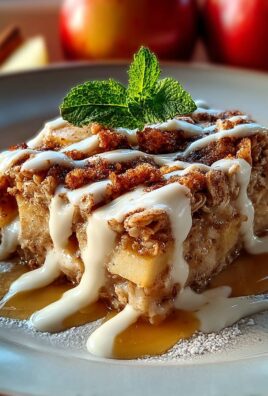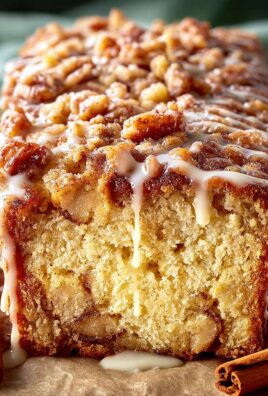Sourdough Apple Fritter Focaccia—prepare to embark on a truly unique culinary journey! When I first conceptualized this dish, I wanted to merge the best of two beloved worlds: the rustic, airy charm of Italian focaccia, and the sweet, comforting indulgence of an apple fritter, all elevated by the unparalleled depth of sourdough. What emerged is a creation that defies expectation, offering a perfect harmony of sweet and savory that will captivate your senses from the very first bite.
This isn’t merely a recipe; it’s an innovative fusion that respects the time-honored tradition of sourdough baking while embracing the playful spirit of a favorite treat. While there isn’t an ancient history for this specific hybrid, it’s a modern testament to how classic components can be reimagined. Think of the crisp, golden crust of focaccia, giving way to an incredibly soft, chewy interior, studded with tender, cinnamon-spiced apple pieces that evoke the warmth of a freshly fried fritter. The natural tang of the sourdough beautifully complements the sweetness of the apples, preventing it from being overly rich and adding a layer of sophisticated flavor.
Why This Dish Will Become Your New Obsession
People absolutely adore this Sourdough Apple Fritter Focaccia because it masterfully combines textures and tastes. You get the satisfying chewiness of a well-made focaccia, the delightful bursts of juicy apple, and that subtle, complex sourdough tang that lingers on your palate. It’s wonderfully versatile—ideal for a luxurious breakfast, a standout brunch centerpiece, or even a unique dessert that’s guaranteed to impress. I am so excited for you to experience the magic of baking and tasting this exceptional creation!

Ingredients:
- For the Sourdough Focaccia Dough:
- 100 grams active sourdough starter (fed and bubbly)
- 375 grams warm water (around 95-100°F / 35-38°C)
- 500 grams bread flour (high protein content works best for structure)
- 10 grams fine sea salt
- 30 grams olive oil, plus extra for the pan and drizzling
- For the Apple Fritter Topping:
- 2 medium-sized apples (Honeycrisp, Fuji, or Granny Smith work wonderfully), peeled, cored, and diced into small 1/4-inch pieces
- 2 tablespoons granulated sugar
- 1 teaspoon ground cinnamon
- 1/4 teaspoon ground nutmeg
- Pinch of ground cloves (optional, but adds depth)
- 1 tablespoon all-purpose flour (to help absorb excess moisture and create a slight jammy texture)
- 1 tablespoon unsalted butter, melted
- For the Vanilla Bean Glaze:
- 1 cup powdered sugar (confectioners’ sugar), sifted to prevent lumps
- 2-3 tablespoons milk (dairy or non-dairy, adjust for desired consistency)
- 1/2 teaspoon vanilla extract or 1/4 teaspoon vanilla bean paste for richer flavor
- Pinch of salt (to balance sweetness)
Phase 1: Preparing the Sourdough Focaccia Dough
- Hydrate the Starter and Autolyse: In a large mixing bowl, combine your active sourdough starter with the warm water. Whisk gently until the starter is mostly dissolved and well-distributed. Add the bread flour to this mixture. Using a spatula or your hand, mix until just combined and no dry streaks of flour remain. The mixture will be shaggy and sticky. This initial mixing without salt is called autolyse, and it’s a critical step for developing gluten structure and allowing the flour to fully hydrate. Cover the bowl with a clean kitchen towel or plastic wrap and let it rest at room temperature for 30 minutes to 1 hour. This resting period significantly improves the dough’s extensibility and makes it easier to work with later.
- Incorporate Salt and Olive Oil: After the autolyse, sprinkle the fine sea salt evenly over the dough. Pour the 30 grams of olive oil over the salt. With wet hands, gently incorporate the salt and oil into the dough. You’ll notice the dough becoming smoother and slightly more pliable almost immediately. Squeeze and fold the dough several times until the salt and oil are fully integrated. The dough might feel a bit slippery at first due to the oil, but keep working it for a minute or two until it starts to absorb.
- First Set of Stretch and Folds: This is where we begin to build strength in our dough. Lightly wet your hands again. Reach under one side of the dough, gently lift it, and stretch it upwards, then fold it over itself towards the center of the bowl. Rotate the bowl 90 degrees and repeat this process three more times, effectively performing four stretch and folds to cover all sides of the dough. You should feel the dough gaining tension and becoming more elastic with each fold. Cover the bowl and let the dough rest for 30 minutes. These gentle folds are crucial for creating that airy, open crumb characteristic of focaccia.
- Subsequent Stretch and Folds: Repeat the stretch and fold process (Step 3) three more times, with 30-minute rest periods between each set. By the end of the fourth set of stretch and folds (totaling about 2 hours from when you added the salt), your dough should be noticeably smoother, more elastic, and possess a good amount of strength. It should be able to hold its shape better and pass a gentle “windowpane test” – where you can carefully stretch a small piece of dough thin enough to see light through it without tearing. If it tears easily, consider one more set of stretch and folds.
- Bulk Fermentation (First Rise): After the final set of stretch and folds, lightly drizzle a bit of olive oil over the dough to prevent it from drying out, then cover the bowl tightly with plastic wrap or a lid. Place the dough in a warm spot (around 72-78°F / 22-25°C) for its bulk fermentation. This process will take anywhere from 4 to 8 hours, depending on the ambient temperature and the activity level of your sourdough starter. You’re looking for the dough to visibly increase in volume by about 50-75%, becoming bubbly and jiggly. It should feel aerated and light when you gently shake the bowl. If you poke it gently with a wet finger, the indentation should slowly spring back. If you are not ready to bake after bulk fermentation, you can retard the dough in the refrigerator overnight (up to 24 hours) for a slower, more complex flavor development. If refrigerating, allow it to come to room temperature for about 1-2 hours before proceeding to the next step.
Phase 2: Preparing the Apple Fritter Topping
- Dice the Apples: While your dough is undergoing its final stages of bulk fermentation, prepare your apple topping. Peel, core, and dice the apples into small 1/4-inch pieces. Consistency in size is key here for even cooking. Smaller pieces will soften beautifully and integrate well into the focaccia.
- Combine Topping Ingredients: In a medium bowl, combine the diced apples, granulated sugar, ground cinnamon, ground nutmeg, and optional ground cloves. Sprinkle in the tablespoon of all-purpose flour. Stir everything together gently until the apples are thoroughly coated with the spices and sugar. The flour helps to absorb any excess liquid released by the apples during baking, preventing the focaccia from becoming soggy and creating a wonderful, slightly jammy texture around the apple pieces.
- Melt Butter: In a small, microwave-safe bowl or on the stovetop, melt the tablespoon of unsalted butter. Set aside. This will be drizzled over the apples just before baking, contributing to a rich, fritter-like flavor.
Phase 3: Assembling and Final Proofing
- Prepare the Baking Pan: Choose a 9×13-inch baking pan (a standard quarter-sheet pan works perfectly) or a 10-inch round cast iron skillet for a thicker focaccia. Drizzle a generous amount of olive oil (about 2-3 tablespoons) into the bottom of the pan, ensuring it coats the entire surface and goes up the sides. A well-oiled pan is essential for that crispy, golden focaccia bottom. You can also line the pan with parchment paper first, then drizzle the olive oil, making removal even easier.
- Transfer the Dough: Carefully scrape your proofed dough out of the bowl and into the prepared baking pan. Try to disturb it as little as possible to retain all those precious air bubbles. The dough will likely be very soft and extensible. Gently nudge and stretch the dough to fill the pan, allowing it to relax and spread naturally. Don’t force it; if it springs back, let it rest for 10-15 minutes, then continue to gently spread it out.
- Dimple the Dough: Drizzle a little more olive oil over the top of the dough. Then, with lightly oiled fingers, gently press down into the dough, creating those signature focaccia dimples. These dimples are not just for aesthetics; they help to trap the olive oil and create pockets for the apple topping, ensuring a rich texture and even distribution of flavor. Be careful not to press all the way through the dough.
- Add the Apple Topping: Evenly scatter the spiced diced apples over the dimpled dough, gently pressing some of the pieces into the dimples. Ensure a good distribution so every slice gets a taste of apple fritter goodness. Drizzle the melted butter prepared earlier over the apples. This butter will mingle with the apple juices and spices, creating a truly irresistible aroma as it bakes.
- Final Proof (Second Rise): Cover the pan loosely with plastic wrap or a large, inverted baking sheet. Let the assembled focaccia proof at room temperature for another 1 to 2 hours. During this final proof, the dough will relax further, allowing the yeast to produce more gas and lighten the crumb even more. You’ll see the dough become visibly puffier, and the apples will settle slightly into the surface. If you gently jiggle the pan, the dough should have a lovely, airy wobble. While it proofs, preheat your oven.
Phase 4: Baking the Sourdough Apple Fritter Focaccia
- Preheat the Oven: About 30-45 minutes before you plan to bake, preheat your oven to 425°F (220°C). A hot oven is crucial for achieving a great oven spring and a crispy crust on focaccia. If you have a baking steel or stone, place it in the oven during preheating for an even crispier bottom crust.
- Bake the Focaccia: Once the oven is fully preheated and the focaccia has finished its final proof, carefully place the baking pan into the hot oven. Bake for 25-35 minutes, or until the top is deeply golden brown, the apples are tender and caramelized, and the bottom crust is crisp. The internal temperature of the focaccia should register around 200-210°F (93-99°C) with an instant-read thermometer, if you choose to check. Don’t be afraid of a deep golden color; that’s where the flavor lives!
- Cooling: Once baked, carefully remove the focaccia from the oven. If you used parchment paper, you can carefully slide the focaccia out onto a wire rack. If not, let it cool in the pan for 5-10 minutes, then use a spatula to loosen the edges and transfer it to a wire rack to cool completely. Cooling on a wire rack prevents the bottom from becoming soggy.
Phase 5: Making the Glaze and Finishing Touches
- Prepare the Glaze: In a medium bowl, whisk together the sifted powdered sugar, 2 tablespoons of milk, vanilla extract (or paste), and a tiny pinch of salt. Continue whisking until the mixture is completely smooth and free of lumps. The consistency should be pourable but thick enough to coat the back of a spoon. If it’s too thick, add more milk a teaspoon at a time. If it’s too thin, add a little more sifted powdered sugar.
- Glaze the Focaccia: Allow the baked Sourdough Apple Fritter Focaccia to cool for at least 30 minutes, or even until it’s just barely warm. If you glaze it while it’s too hot, the glaze will melt and disappear. Drizzle the vanilla bean glaze generously over the top of the cooled focaccia. You can use a spoon to create an artistic pattern or simply pour it over for an even coating. The glaze adds that quintessential “fritter” sweetness and sheen, making this focaccia truly special.
- Serve: Let the glaze set for a few minutes before slicing and serving. This Sourdough Apple Fritter Focaccia is best enjoyed fresh on the day it’s baked, perhaps with a cup of coffee or as a delightful dessert.
Tips for Success with Your Sourdough Apple Fritter Focaccia:
Don’t Rush the Proofing: Sourdough baking requires patience. The bulk fermentation and final proof are critical for flavor development and texture. Always go by how the dough looks and feels rather than strictly by the clock, as ambient temperature and starter strength can vary. If your kitchen is cooler, your proofing times will be longer. Conversely, in a warmer environment, the dough will proof more quickly. Learning to read your dough is the most valuable skill in sourdough baking.
Quality Ingredients Matter: Using good quality bread flour will significantly impact the focaccia’s structure. A high-protein flour helps develop strong gluten, leading to a chewy interior. Similarly, a robust, fruity olive oil will lend a beautiful aroma and taste to the base of your focaccia, enhancing the overall experience. Don’t skimp on fresh, crisp apples either; they provide the perfect balance to the sweet and spiced elements.
Experiment with Apple Varieties: While Honeycrisp and Fuji offer a nice balance of sweetness and tartness, don’t hesitate to try other varieties. Granny Smith apples will give a more tart contrast, while Golden Delicious will be softer and sweeter. Mixing two types can also create a more complex flavor profile in your Sourdough Apple Fritter Focaccia.
Customize Your Spices: Feel free to adjust the spice blend for the apples to your preference. A little cardamom could add an exotic touch, or a touch more cinnamon if you’re a big fan. Ensure the spices are fresh for maximum potency and aroma.
Pan Choice: A darker metal pan will generally result in a crispier bottom crust because it absorbs and radiates heat more efficiently. If you prefer a lighter, softer bottom, a lighter-colored pan or a ceramic dish might be better. A cast iron skillet also works wonders for a super crispy crust.
Deeper Dimples for More Topping: When dimpling, don’t be afraid to create deep impressions, especially if you want your apple topping to nestle down into the focaccia more thoroughly. These dimples are where the delightful pockets of caramelized apple and spice will reside, making each bite incredibly flavorful.
Glaze Consistency is Key: For the best aesthetic and taste, ensure your glaze is not too runny, or it will just melt away. It should be thick enough to leave a white, opaque drizzle. If you find your glaze too thin, simply add more sifted powdered sugar, a tablespoon at a time, until you reach the desired consistency.
Serving Warm: While the focaccia needs to cool somewhat for the glaze to set, serving it slightly warm after the glaze has hardened is absolutely heavenly. The warmth brings out the spices and the softness of the baked apples.
Storage and Reheating:
Your Sourdough Apple Fritter Focaccia is undeniably best enjoyed on the day it is baked. The crust is at its crispiest, and the interior is perfectly soft and fragrant. However, if you have leftovers, they can be stored.
Storage: Store the focaccia at room temperature, loosely covered, for up to 2 days. To maintain some of its freshness, you can wrap it in aluminum foil. Avoid airtight containers for too long, as this can make the crust soggy. If keeping it longer, it’s best to store it in the refrigerator for up to 4 days, though the texture will change slightly, becoming denser.
Freezing: For longer storage, you can freeze individual slices or larger pieces of the unglazed focaccia. Wrap it tightly in plastic wrap, then in aluminum foil, and place it in a freezer-safe bag. It will keep in the freezer for up to 1 month. If freezing with the glaze, the glaze might become a little watery upon thawing, but the flavor will still be there.
Reheating: To reheat, a toaster oven or conventional oven works best. If frozen, thaw it at room temperature first. Place slices directly on a baking sheet and warm them at 350°F (175°C) for about 5-10 minutes, or until warmed through and the crust has crisped up again. Be careful not to overheat, especially if it has glaze, as the sugar can burn. The microwave is an option for quick reheating, but it will soften the crust significantly.

Conclusion:
If there’s one recipe I genuinely hope you’ll add to your baking repertoire this year, it’s this extraordinary creation. I’ve poured my heart into perfecting it, and I truly believe it’s a game-changer for anyone who loves the comforting embrace of sourdough, the sweet tang of apples, and the satisfying texture of a perfectly baked focaccia. This isn’t just another treat; it’s an experience, a delightful fusion that elevates familiar flavors into something truly novel and utterly irresistible. Imagine the aroma filling your kitchen as it bakes – a warm, inviting symphony of cinnamon, baked apples, and that unmistakable, wholesome scent of sourdough. It’s enough to make your mouth water before you even take the first bite.
What makes this recipe a definite must-try, you ask? Well, it’s the masterful blend of textures and tastes that truly sets it apart. You get the signature chewy, airy crumb of a focaccia, imbued with the complex, slightly tangy notes only a well-nurtured sourdough starter can provide. Then, nestled within this soft embrace, you encounter pockets of tender, caramelized apple pieces, sweet and slightly tart, reminiscent of the best apple fritters you’ve ever had. The surface, often sprinkled with a coarse sugar, bakes to a beautiful golden crisp, offering a delicate crunch that perfectly contrasts the pillowy interior. It’s a symphony of sweet, tangy, soft, and crisp, all in one glorious bite. It’s a recipe that genuinely surprises and delights, proving that innovation in the kitchen can lead to truly spectacular results.
I’ve found that this incredible creation shines in so many different scenarios. For a truly indulgent breakfast or a leisurely brunch, serve slices of your warm Sourdough Apple Fritter Focaccia alongside a strong cup of coffee or a fragrant tea. The slight tang of the sourdough provides a wonderful counterpoint to the sweetness, making it remarkably balanced. It also makes for an absolutely spectacular dessert. Imagine it served warm, perhaps with a scoop of vanilla bean ice cream melting into its crevices, or a dollop of freshly whipped cream. The warm apples and spicy notes come alive when paired with the cool, creamy richness. For a more casual afternoon treat, simply enjoy a generous slice on its own, perhaps with a light dusting of powdered sugar or a delicate drizzle of maple syrup. It’s robust enough to satisfy but light enough not to feel heavy.
And the beauty of this recipe doesn’t stop there; it’s incredibly versatile, inviting you to put your own creative spin on it. While apples are divine, don’t hesitate to experiment with other fruits. Pears, especially Bosc or Anjou, would be a fantastic substitute, offering a slightly different texture and sweetness. Mixed berries, like blueberries and raspberries, could add a burst of tartness and vibrant color, especially when fresh and in season. You could also introduce different spices – a pinch of nutmeg or a hint of cardamom would beautifully complement the apple and sourdough flavors. For an added layer of texture, consider sprinkling some chopped walnuts or pecans over the top before baking. If you’re feeling particularly adventurous, you could even explore a savory twist by omitting the sugar and using caramelized onions, cheese, and fresh herbs, though that would be a departure from the “fritter” aspect! The possibilities truly are endless once you understand the core technique.
Baking with sourdough is a journey, and every bake is a new adventure. This recipe, in particular, has become a cherished favorite in my own kitchen, not just for its incredible taste, but for the sheer joy it brings when shared. There’s a profound satisfaction that comes from transforming simple ingredients into something so unique and delicious, especially when working with a living starter. So, I wholeheartedly encourage you to roll up your sleeves, feed your starter, and dive into the wonderful world of this Sourdough Apple Fritter Focaccia. Don’t be intimidated; the process is incredibly rewarding, and the result is truly worth every moment.
I genuinely can’t wait for you to experience the magic of this recipe for yourself. It’s more than just baking; it’s an adventure in flavor and texture, a true testament to the versatility of sourdough. Once you’ve pulled your golden masterpiece from the oven, please, please share your creations with me! I absolutely adore seeing your baking successes. Tag me on social media, leave a comment below, or send me an email. Tell me about your favorite variations, your serving suggestions, or simply how much you and your loved ones enjoyed this unique treat. Happy baking, my friends – I have a feeling this will quickly become a new staple in your home!
Frequently Asked Questions (FAQs)
What kind of apples are best for Sourdough Apple Fritter Focaccia?
For this recipe, I recommend using apples that hold their shape well when baked and offer a good balance of sweetness and tartness. Granny Smith, Honeycrisp, Braeburn, or Fuji are excellent choices. A mix of a tart apple (like Granny Smith) and a sweeter one (like Honeycrisp) can create a wonderful depth of flavor.
Can I use active dry yeast instead of sourdough starter?
While the recipe is specifically designed to leverage the unique flavor and texture of sourdough, you can adapt it by using active dry yeast. You would need to adjust the liquid content and fermentation times significantly. For a similar focaccia texture, I’d suggest using about 1.5-2 teaspoons of active dry yeast proofed in warm water or milk, and then following a standard focaccia recipe while incorporating the apple fritter elements. However, you will miss the characteristic tangy depth that sourdough provides.
How do I store Sourdough Apple Fritter Focaccia?
Once completely cooled, store your focaccia in an airtight container at room temperature for up to 2-3 days. For longer storage, you can wrap individual slices tightly in plastic wrap and then aluminum foil, and freeze them for up to 1-2 months. To reheat, thaw at room temperature and then warm in a toaster oven or conventional oven at 350°F (175°C) until heated through and lightly crisped.
What if my sourdough starter isn’t very active?
An active, bubbly starter is crucial for a good rise and texture. If your starter seems sluggish, give it a few extra feedings at its peak activity over 1-2 days before you plan to bake. Make sure you’re using it when it’s at its most vigorous – typically 4-8 hours after feeding, when it has doubled in size and is full of bubbles. Using a weak starter can result in a dense, flat focaccia.
Can I make this recipe gluten-free?
Adapting a sourdough recipe to be gluten-free can be challenging due to the specific gluten structure required for the focaccia texture. You would need to use a gluten-free sourdough starter and a blend of gluten-free flours (e.g., rice flour, tapioca starch, sorghum flour) that mimics the properties of wheat flour, often with the addition of xanthan gum. While it’s possible, it requires specific expertise in gluten-free sourdough baking and may yield a slightly different texture.

Best Sourdough Apple Fritter Focaccia: Sweet & Tangy
Prepare to embark on a truly unique culinary journey with this Sourdough Apple Fritter Focaccia. Merging the rustic, airy charm of Italian focaccia with the sweet, comforting indulgence of an apple fritter, and elevated by the depth of sourdough, this innovative fusion offers a perfect harmony of sweet and tangy flavors. It’s a versatile dish, ideal for breakfast, brunch, or a unique dessert.
Ingredients
-
125g active sourdough starter
-
450g water, room temperature
-
30g raw honey
-
675g bread flour
-
12g coarse sea salt (for dough)
-
60g unsalted butter, divided (30g for dough, 30g for pan)
-
1 large apple (Honeycrisp), peeled, cored, diced
-
12g granulated sugar
-
75g brown sugar
-
2g ground cinnamon
-
2g coarse sea salt (for topping)
-
8g bread flour (for apples)
-
15g unsalted butter, melted (for apple topping)
-
125g powdered sugar, sifted
-
30g milk
Instructions
-
Step 1
In a large bowl, combine active sourdough starter, warm water, and raw honey. Whisk until starter dissolves. Add 675g bread flour; mix until shaggy. Cover and autolyse for 30-60 minutes. After autolyse, sprinkle 12g coarse sea salt and pour 30g melted unsalted butter over the dough. Mix with wet hands until fully incorporated. Perform 4 sets of stretch and folds, resting 30 minutes between each set. After the final set, cover tightly and bulk ferment in a warm spot for 4-8 hours until visibly increased in volume by 50-75%. -
Step 2
While dough bulk ferments, peel, core, and dice the large apple into 1/4-inch pieces. In a medium bowl, combine diced apples, 12g granulated sugar, 75g brown sugar, 2g ground cinnamon, 2g coarse sea salt, and 8g bread flour. Stir until apples are coated. Melt 15g unsalted butter; set aside. -
Step 3
Generously grease a 9×13-inch baking pan with the remaining 30g melted unsalted butter. Carefully transfer the proofed dough to the pan; gently stretch to fill. Drizzle a little melted butter over the dough, then dimple deeply with oiled fingers. Evenly scatter the spiced diced apples over the dimpled dough, gently pressing some into the dimples. Drizzle the 15g melted butter (for apples) over the topping. Cover loosely and final proof at room temperature for 1-2 hours, until puffy. Preheat oven to 425°F (220°C) during the last 30-45 minutes of proofing. -
Step 4
Bake in the preheated oven for 25-35 minutes, or until deeply golden brown and the apples are tender and caramelized. Remove from oven and transfer to a wire rack to cool completely. -
Step 5
In a medium bowl, whisk together 125g sifted powdered sugar and 30g milk until completely smooth and pourable. Once the focaccia has cooled (at least 30 minutes, or until barely warm), generously drizzle the glaze over the top. Let the glaze set for a few minutes before slicing and serving. Best enjoyed fresh.
Important Information
Nutrition Facts (Per Serving)
It is important to consider this information as approximate and not to use it as definitive health advice.
Allergy Information
Please check ingredients for potential allergens and consult a health professional if in doubt.
Printable Recipe Card
Want just the essential recipe details without scrolling through the article? Get our printable recipe card with just the ingredients and instructions.




Leave a Comment